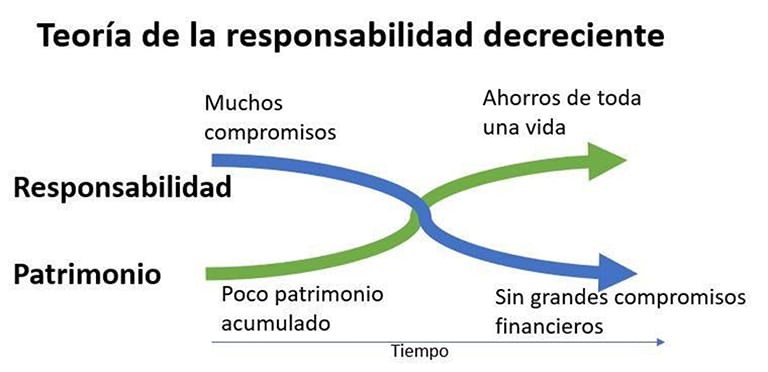In other words, these policies allow you to plan your finances and get the level of protection you need at any given moment. For this very reason, the question of when it is advisable to take out a life insurance policy goes hand in hand with specific phases of life, and something similar happens with the amount of the cover.
When is it best to take out life insurance?
There are a number of typical situations where it is normal to think about the additional protection provided by life insurance, like:
- When you buy a house, regardless of whether this is offered by the bank.
- When you start your life as a couple or get married and one of you earns more than the other.
- When you have children or are starting a family.
Can you see the link between these three situations? In all of them, the obligations to be met exceed the resources available at the time.
This is what is known as the theory of decreasing responsibility, one of those terms used in the insurance world to refer to something as simple as the need for the protection you will require at each moment of your life and, yes, also when it is advisable to take out life insurance or protection insurance and how much it should be.
What is the theory of decreasing responsibility?
This theory establishes a connection between resources and responsibilities throughout life. In other words, it connects your wealth or the money you have with your financial obligations.
This relationship will determine the level of protection you need at any given time, which is calculated by the difference between one and the other.
To help you understand this better, imagine a typical person’s financial and life history. When you are young, you have little money, but also few financial responsibilities. After all, no-one is depending on you and you may even live with your parents. Consequently, you don’t need a lot of additional protection.
As life goes on, you earn more money and increase your wealth, but you also increase your obligations and responsibility. For example, when you buy a house, you will have a huge mortgage debt, and probably little or no money saved if you have just bought the house.
If, in addition, you move in with your partner and start a family, your current and future responsibilities will suddenly grow, again beyond your current income and assets. Naturally, you will want to take care of your children and guarantee them a future no matter what happens to you and your income.
Time will go by, your children will go to college, they will start working (or not), and you will finish paying off the house. In other words, your personal and financial responsibilities will decrease over time.
What about your wealth? Typically it will have increased over time, especially if you have started investing. In fact, if you did so early, compound interest will have helped you accumulate a nice sum.
According to the theory of decreasing responsibility, at the end of your life you will have more wealth than responsibilities, and that makes sense. When you reach old age or retirement, it is normal that your house will be paid for and you will have no responsibilities because your children will have grown up.
In fact, rather than responsibilities, at that age we could talk about goals and desires, such as traveling or helping your children.
Just in case you still don’t fully understand, the following diagram from Preahorro.com sums up the theory.

Image source: https://preahorro.com/wp-content/uploads/La-teoria-de-la-responsabilidad-decreciente.jpg
Bridging the gap between resources and wealth
If the theory of diminishing responsibility is useful for deciding when to take out life insurance and how much it should be for, it is because insurance is one of the ways for addressing this problem.
Specifically, life insurance can cover the difference between what you have already saved and your actual liabilities, as can default insurance or home insurance if you have a mortgage (think about what would happen if your house burned down, for example).
That is why this theory is very useful for determining when to take out this type of policy, which is effectively when there is a shortfall between your wealth and your financial obligations (for example, when you take out a loan).
It can also be useful to find out how much your life insurance should be, which would cover the difference between one figure and the other, as we will see later on with the example of a mortgage.
Are there other solutions besides insurance? Yes, investments can help you bridge the gap. Here you can see a guide to how much to invest according to your situation.
Among the options, there is one product in particular that unites the two worlds: life insurance and investment. These are life-savings insurance systems, such as PIAS or Unit Linked schemes, which include a life insurance policy while being an investment and/or savings tool at the same time.
Through these you can obtain the life cover you need, in other words, an indemnity in case of death or disability, and a tool to expand your savings through a portfolio of investment funds, as is the case with Unit Linked plans.
As your wealth grows, you can reduce the insurance capital through a single product, something you can also do on your own using a separate investment portfolio and insurance.
The mortgage example
Buying a house with a mortgage is usually synonymous with taking out a life insurance policy. Beyond the fact that banks tend to discount the loan terms, this policy is a good protection measure and a good example of what we have just seen.
The most typical thing when acquiring a home is to allocate almost all your savings to pay the down payment on the property. This makes the gap between your wealth and what you owe huge, a hole that should be covered with life insurance.
This way, you know that, if something happens to you, your family will be able to pay for the house and will not lose their home. For this reason, the most common thing to do is to sign an insurance policy for the value of the mortgage and reduce the insured amount year after year.









